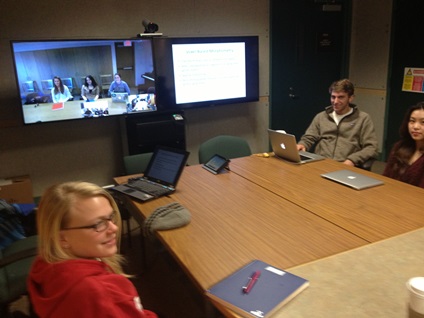Sharing Instruction

(Photo courtesy of Matt Kurtz, Wesleyan University) |
This spring, Wesleyan University psychology professor Matthew Kurtz taught a course on schizophrenia that he's taught several times before. But this semester was different: Only six of the 15 people taking the class were Wesleyan students meeting at the Middletown, CT campus. The other students -- five from Connecticut College in New London and three from Trinity College in Hartford -- participated in the class via videoconference.
The class is part of an experiment to test the concept of sharing instruction among schools. The idea came from a summer meeting of the schools in the New England Small College Athletic Conference (NESCAC) a few years ago, in which associate deans brainstormed about ways to better share resources.
"We thought that because we already collaborate to share library resources, perhaps we could do something to share in terms of instruction," recalled Melanie Stein, associate academic dean and professor of mathematics at Trinity. "We came up with several examples of how we might increase the availability of courses to students in departments that are small and where it is difficult for us to offer wide and rich course offerings," she said.
The three schools decided to start with Kurtz’s schizophrenia course -- giving Trinity and Connecticut College students access to a specialized topic that the psychology professors at those schools don't have the expertise to teach.
Connecting the Classrooms
The students attended the Wesleyan course at their respective campuses, with remote students tuning in via videoconference.
At Trinity, for example, students met in a small seminar classroom outfitted with two 55-inch displays, placed side-by-side. One display showed the course material and the other showed the students in other locations (as well as a small window where the Trinity students could see themselves). Students raised their hands with questions and Kurtz called on them just as he would if they were in the Wesleyan classroom. Exams were uploaded to a shared private Web site, and Kurtz offered office hours via Skype. The class used Wesleyan’s course management system, and Trinity and Connecticut College students were assigned a Wesleyan e-mail address and ID. To build the students’ interpersonal relationships, the class went on a field trip together to Connecticut Valley Hospital early in the course.
Tech Details
Trinity and Wesleyan use identical Cisco TelePresence systems and they interface well with Connecticut College’s Polycom system, reported Jolee West, Wesleyan’s director of academic computing services and digital library projects. Wesleyan has a conference room that hooks into the statewide high-speed Connecticut Education Network and this course has used that link. "We should be able to do point-to-point connections as well," she noted, "but the networking people are currently diagnosing some issues they found with those."
"Not everything is exactly as we would like it," West added. For instance, the frame rate on the screen for the course material is not fast enough to show videos, so when Kurtz wants to show those, he has to switch screens. "It’s not ideal," she said, "but this is our first iteration."
West described the setup: The left-hand display (showing the students) uses an "equal" layout, where the remote locations are shown side-by-side with the self-view at the bottom. The right-hand display is used for presentation materials. "There are several layouts possible, but this is the one we all liked the best," she said. "Layout is a local configuration, so each endpoint can choose what layout to use."
West said Wesleyan has ample network bandwidth, allowing the university to expand the project as needed. If the university had two courses running simultaneously, however, it would need to add another videoconferencing unit somewhere else on campus. "This one is in the science center," she said, "so we have thought of adding another one on the other side of campus in humanities."
One challenge of expanding the collaboration is getting the schedules to work. Each school has a different spring break, for example. For the schizophrenia course, Trinity students had to attend class during their spring break. "We have no plans to do this with large classes -- just small classes with very dedicated students," Stein said, "so they are usually willing to have this type of flexibility about schedules."
Next Steps
Whether the shared course idea catches on will depend in part on student and faculty evaluations. "I think it is a feasible, sustainable model," Kurtz said, "but it will be interesting to see what student evaluations say. There may be something lost from the vibrancy of discussion of literature and clinical cases. Although they interact well with me, the students don’t seem to be interacting with each other that much in class. But the technology has definitely improved."
All three campuses are enthusiastic about the potential of sharing instructional resources, Stein said. Earlier experiments didn’t succeed in part because the technology didn’t function as well, she added, "but we believe the technology is no longer a barrier."
Stein acknowledged that some faculty members express concerns that this is a means for the administration to cut faculty numbers. "But this is not cutting," she stressed. "This is looking to do more with the same faculty. When we explain that cutting is not what this is about, they get it and are interested."